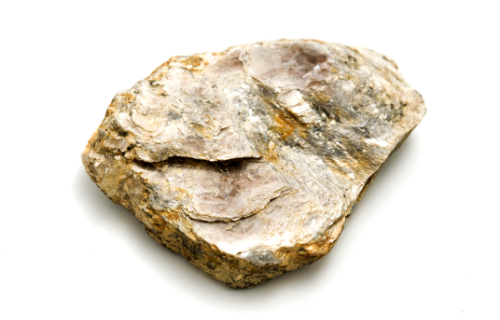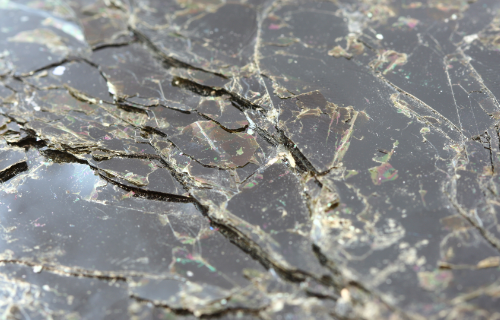Difference Between Muscovite and Biotite
Let’s just talk about phyllosilicates first before we jump into our main topic of interest. So, phyllosilicates, or sheet silicates, refer to a large group of minerals that include micas, smectites, chlorites, and kaolinites among others. Silicate minerals are among the largest group of minerals that make up nearly 90 percent of the Earth’s crust and phyllosilicates are one of the seven groups of silicate minerals. Mica is a large group of sheet silicates, all of which boast a sheet-like structure. Muscovite and Biotite are two of the common variations of the mica family of minerals.

What is Muscovite?
Muscovite belongs to the mica family of minerals. Also called the potash mica or white mica, muscovite is a hydrated sheet silicate mineral of aluminum and potassium. It’s the most common member of the mica family of minerals that is found in igneous, metamorphic, and sedimentary rocks. It’s kind of a clear sheet of mineral and ranges from colorless to yellowish or pale gray. You can actually see your hand on the other side of the sheet. One of the most defining characteristics of muscovite is its perfect basal cleavage, and combines that with its elasticity, it can be peeled off into thin sheets.
The perfect cleavage means you can actually pull apart the crystal into very thin elastic sheets. These sheets are a perfect replacement for glass, which can be used for high temperature industrial applications such as furnace doors or oven windows. It can also be used as an insulating material for the manufacturing of electrical apparatus or as fillers in paints, surface treatments, plastic, and other manufactured products.

What is Biotite?
Biotite is yet another common group of sheet silicate minerals within the mica group found in a wide range of metamorphic rocks such as granites, pegmatites, peridotites, and other igneous rocks. Like muscovite, it is a sheet mineral of the mica group except it contains magnesium and potassium. Biotites are also known as black micas because they are usually dark green, brown or black in color. They exhibit high interference colors in cross-polar light. Iron is the key element in biotites, which give it a dark or black appearance.
Like muscovite, it has a perfect basal cleavage and is distinguished by its one direction of cleavage. So, it peels off in thin sheets, just like muscovite. Sometimes, biotites are confused being metallic in color because they are reflective and shiny. When found in large chunks, biotites are often called books because they look like books with layers of page-like sheets. Another interesting fact about biotites is that they are not very resistant to weathering and transform into clay minerals. One of the most common uses of biotite is to determine the age of rocks through a process called argon-argon dating or potassium-argon dating.
Difference between Muscovite and Biotite
Composition
– Both muscovite and biotite are the two common members of the mica family of minerals called phyllosilicates. Both the minerals boast a similar sheet-like structure. The difference lies in their composition. Muscovite is a hydrated sheet silicate mineral that contains potassium and aluminum. Biotite is also a common group of sheet silicate mineral of the mica group except it contains magnesium and potassium.
Color
– Another distinguishing factor between the two minerals is their color. Muscovite is like a clear sheet of mineral with a crystal shape and ranges from colorless to yellowish or pale gray or pale green. It sometimes looks like coppery silver depending on the thickness of the sample. Biotite, on the other hand, is black mica because it appears dark green, brown or black in color. Iron is the key element in biotites, which give it a dark or black appearance.
Uses
– Muscovites are a perfect replacement for glass, which can be used for high temperature industrial applications such as furnace doors or oven windows. They are also used in the manufacturing of fireproofing materials, insulating materials, or as lubricants. Biotites have relatively less commercial uses compared to muscovites. However, biotites are extensively used to determine ages of rocks, either by argon-argon dating or potassium-argon dating process.
Muscovite vs. Biotite: Comparison Chart

Summary
Muscovites are white micas because they appear clear, white, silvery, yellowish, or sometimes pale gray in color. Biotites are black micas because they appear dark, greenish-brown, blackish-brown, or reddish black in color. Both the minerals have a perfect basal cleavage and consist of flexible sheets which flake off easily. One of the key differences between the two minerals, apart from the color difference, is that muscovites contain potassium and aluminum whereas biotites composed of potassium and magnesium.
What are the distinguishing properties between biotite mica and muscovite mica?
Biotite is black mica and appears dark in color whereas muscovite is white mica and appears white or silvery or even colorless.
Why does biotite and muscovite have different names?
The name muscovite owes its name to Muscovy glass, a mineral used in Russia for making windowpanes. Biotite was named by German mineralogist Johann Friedrich Hausmann in 1847 in honor of French Physicist Jean-Baptiste Biot.
How are the minerals biotite and muscovite different quizlet?
Muscovite is colorless but biotite is not and biotite contains iron, but muscovite does not. Muscovite is light in color but biotite appears dark in color.
What elements does biotite contains that muscovite does not?
Biotite contains iron and/or magnesium, but muscovite does not. In fact, muscovite contains potassium and aluminum.
- Difference Between Caucus and Primary - June 18, 2024
- Difference Between PPO and POS - May 30, 2024
- Difference Between RFID and NFC - May 28, 2024
Search DifferenceBetween.net :
Leave a Response
References :
[0]Essington, Micheal E. Soil and Water Chemistry: An Integrative Approach. Florida, United States: CRC Press, 2003. Print
